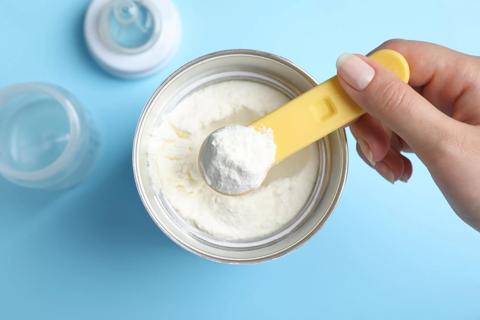Gentle massaging, lying on your side and hand-expressing a little milk can help

Our bodies come in all shapes and sizes, with a vast array of features and qualities that make us uniquely beautiful. Embracing that mentality can be an important part of everyday functional activities like breastfeeding (chestfeeding). If you have flat nipples, though, you might’ve heard about the impossibilities of breastfeeding — but your nipples don’t have to stand at attention to do their job.
Advertisement
Cleveland Clinic is a non-profit academic medical center. Advertising on our site helps support our mission. We do not endorse non-Cleveland Clinic products or services. Policy
Pediatrician and breastfeeding medicine specialist Heidi Szugye, DO, IBCLC, clears up the confusion around flat nipple misconceptions and how to breastfeed if you have them.
Good news: Your nipples don’t need to resemble a baby bottle to breastfeed. And on top of that, many people mistakenly think they have flat nipples when they don’t.
“Nipples come in many shapes and sizes, and not everyone has nipples that stick out,” clarifies Dr. Szugye. “Some people think they have flat nipples, but they just have nipples that are flat when they’re not stimulated.
“And even if you have flat nipples, they often come out on their own with a little help.”
Many tricks — from a breast massage to finding the right position — can help you successfully breastfeed with flat nipples. These tips will help you and your baby get into a good breastfeeding groove:
You can encourage a flat nipple to be more prominent with a “stenting” trick. When you’re getting ready to feed your baby:
Advertisement
After giving birth, it’s common for people to have excess fluid in their bodies. This is more likely if you:
The extra fluid in your body can also make your breasts feel more taut and swollen. Your nipples can become flatter, making it hard for your baby to latch on. But you can drain some of this excess fluid with a lymphatic drainage massage.
You can perform this massage sitting up or lying on your back before each feeding:
Lying in a reclined position can make breastfeeding easier if you have flat nipples due to engorgement or swelling.
“When you’re sitting up, gravity is more likely to draw excess fluid behind the areola,” explains Dr. Szugye. “The fluid will move away from this area if you’re lying down on your side or back. Your areola and nipple area will be softer, making it easier for your baby to latch on.”
Nipples are erectile tissue, meaning they can become stiffer and fill with blood if you touch them. This can work to your advantage if your nipples are flat.
“Try a gentle sweeping motion, starting on your areola and moving outward,” instructs Dr. Szugye. “Often, this light stimulation is enough to get the nipple out. You can also place a cool washcloth or cold baby wipe over your nipple for a few seconds.”
Engorgement and flat nipples aren’t a good combination.
“Engorged breasts are too firm for most babies, and they won’t be able to latch on and draw a flat nipple out,” notes Dr. Szugye. “If you’re engorged, hand-express or pump a little milk — just enough to soften your breast.”
Then, place a few drops of your expressed milk on your nipple. Let your baby smell and taste the sample, which may encourage them to latch on. A technique called “reverse pressure softening” — which can be performed by applying gentle pressure with your fingertips toward your chest wall over the circumference of your areola — can be helpful for softening the nipple/areola area and make it easier for your baby to latch.
Whatever you do, don’t go overboard. If you pump too much, your supply will increase, leaving you with engorged breasts again.
Advertisement
With flat nipples, it’s easy to think your baby should focus on pulling your nipple out. But this will often happen naturally if your baby has the proper latch.
“When latching, your baby should open their mouth wide and get your areola and some breast tissue in their mouth,” Dr. Szugye explains. “As they feed, they create a vacuum that pulls your nipple outward. If you focus on putting only your nipple in their mouth, breastfeeding can be painful.”
Many stores carry breastfeeding devices like shields and shells that look helpful. And it’s tempting to think these might be just what you need to succeed if you have flat nipples. But they may not help you and could even be harmful.
“Breast shells can squeeze the area around your nipple and injure your breast tissue,” warns Dr. Szugye. “Nipple shields block the sensation of breastfeeding, lowering your milk supply over time. Studies also show that babies get less milk when you wear a nipple shield during feedings.
“Sometimes, we do use them to temporarily assist with latching, but they should always be used in conjunction with the care of a trained lactation consultant or breastfeeding medicine provider with close follow up and a goal of eventual latch without a shield.”
Advertisement
If you’re struggling with breastfeeding — you don’t have to go at it alone. Contact a lactation consultant or breastfeeding specialist.
“A breastfeeding expert can help you with your specific challenges or concerns,” reassures Dr. Szugye. “It’s one of the best things you can do for you and your baby if you’re struggling with breastfeeding for any reason.”
Breastfeeding is challenging enough without wondering whether your nipple is the “right” shape. Don’t let this stop you from enjoying this special time as you bond with your baby.
“Breastfeeding is possible for people with flat nipples,” reiterates Dr. Szugye. “Many people are pleasantly surprised that their flat nipples work just fine. With the right technique and support, most people can have a positive breastfeeding experience.”
Advertisement
Learn more about our editorial process.
Advertisement

When breastfeeding doesn’t go as planned, you may need to supplement with formula or donor breast milk — and that’s OK

Breastfeeding supplements can be a needless expense at best, and risky at worst

Typically, milk comes in a few days after birth and regulates around four weeks after delivery

From the football hold to the cradle hold, consider trying a variety of techniques

Get your milk flowing by getting comfy, releasing stress and focusing on your baby

Popular myth says breastfeeding prevents pregnancy, but that’s not the whole story

With some exceptions, most are OK

Removing the piercing as early as possible is important for avoiding complications

Type 2 diabetes isn’t inevitable with these dietary changes

Applying a hot or cold compress can help with pain